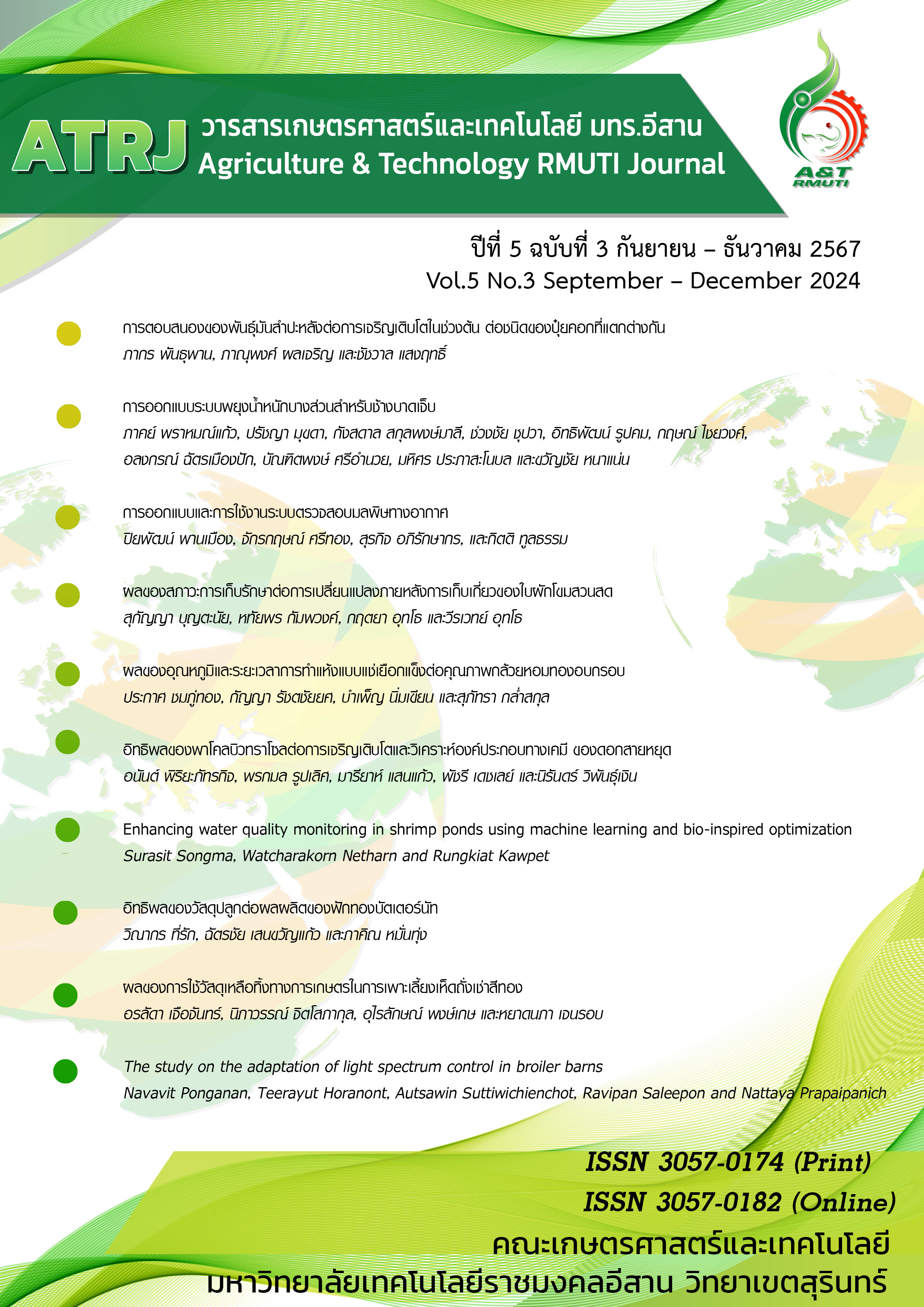The design of partial weight-support system for injured elephants
Keywords:
Elephant, Injured elephant, Partial weight-support systemAbstract
This research aims to design a partial weight-support system for injured elephants, with the primary goal of providing preliminary care for elephants that have been injured and are unable to stand on their own before being transported to a hospital for further treatment. The process of assisting injured elephants must be rapid and safe for both the caretakers and the elephants. This weight-support system is designed to facilitate the assistance of injured elephants and can be towed by a standard pickup truck at speeds not exceeding 60 km/hr. The design takes into consideration the optimal weigh that the system can lift, which is approximately 14.7 kN, calculated as 30% of the average weigh of adult Thai elephants, which is 49.1 kN. The chest circumference and height of adult Thai elephants used in this design are on average of 400 and 300 cm, respectively. Testing the weight-lifting system in a laboratory setting showed that it can lift
a maximum weight of 19.6 kN at a height of 3.5 meters. When applied to an injured elephant weighing
49.1 kN, the stability factor (N) is 1.33.
References
ข่าวสด. (2565). น่าสงสาร! รถขนช้างคว่ำ 'ปู๊คำ' บาดเจ็บ ขยับตัวแทบไม่ได้. ค้นเมื่อ 10 พฤศจิกายน 2566. https://www.khaosod.co.th/around-thailand/news_7248753
ไทยรัฐออนไลน์. (2561). ย้ายลูกช้างเข้ารักษาตัว รพ.สนาม อช.กุยบุรี คาดใช้เวลา 3 เดือน. ค้นเมื่อ 15 กันยายน 2565. https://www.thairath.co.th/news/local/central/1450273
ไทยพีบีเอส. (2560). เปิดนาทีชีวิตช่วย "ช้างป่า"ตกคลองชมพู 26 ชั่วโมง. ค้นเมื่อ 15 กันยายน 2565. https://www.thaipbs.or.th/news/content/267028.
ไทยพีบีเอส. (2564). 7 วันรู้ผล "พลายยันหว่าง" ช้างป่าตาย สงสัยให้ยาเกินขนาด. ค้นเมื่อ 15 กันยายน 2565. https://www.thaipbs.or.th/news/content/300673
ไทยพีบีเอส. (2565). นาทีชีวิต ช่วยช้างป่า "แม่-ลูก" ตกท่อระบายน้ำ ลึก 2 เมตร. ค้นเมื่อ 10 พฤศจิกายน 2566. https://www.thaipbs.or.th/news/content/317479
พุทธิพงษ์ พลคำฮัก. (2556). อุปกรณ์ช่วยเดิน. วารสารศรีนครินทร์เวชสาร. 28(4): 583-588.
พรพรรณ เครืออนุณรัตน์. (2560). การศึกษาและพัฒนาอุปกรณ์ช่วยพยุงสำหรับผู้สูงอายุ. วิทยานิพนธ์ปริญญาครุศาสตร์อุตสาหกรรมมหาบัณฑิต สาขาวิชาเทคโนโลยีการออกแบบผลิตภัณฑ์อุตสาหกรรม คณะครุศาสตร์อุตสาหกรรมและเทคโนโลยี สถาบันเทคโนโลยีพระจอมเกล้าเจ้าคุณทหารลาดกระบัง.
วรัตถ์ สิทธิ์เหล่าถาวร. (2559). การออกแบบโครงช่วยฝึกเดินที่มีระบบพยุงน้ำหนักบางส่วนสำหรับผู้ที่มีปัญหาการเคลื่อนไหวด้านการเดิน. วิทยานิพนธ์ปริญญาวิศวกรรมศาสตรมหาบัณฑิต ภาควิชาวิศวกรรมเครื่องกล คณะวิศวกรรมศาสตร์ มหาวิทยาลัยธรรมศาสตร์.
วรรณนา สุริยาสถาพร, วีนา จูเปีย, อติกันต์ ทองทาบ, เกรียงไกร ทองก้อน, กณวีร์ วาฤทธิ์ และเทอดชัย ชีวะเกต. (2558). ขาเทียมสำหรับสุนัข. วารสารเชียงใหม่สัตวแพทย์สาร. 13(3): 139-146.
วาริชภัทร จ่ายเจริญ. (2563). การพัฒนาสมการถดถอยเพื่อประมาณน้ำหนักของช้างเอเชียโดยใช้การวิเคราะห์ภาพถ่ายดิจิตอล. วิทยานิพนธ์ปริญญาสัตวแพทยศาสตรบัณฑิต คณะสัตวแพทยศาสตร์ มหาวิทยาลัยเชียงใหม่.
ศูนย์ประสานการปฏิบัติที่ 4 กอ.รมน. (2565). เอาใจช่วย! ช้างป่าใจสู้ “บุญรอด” บาดเจ็บสาหัส. ค้นเมื่อ 10 พฤศจิกายน 2566. https://4occ.isoc.go.th/04news/?p=7679.
สมาคมสหพันธ์ช้างไทย. (2566). ช่วยเหลือช้างสีดอทองหล่อ อายุ 63 ปี. ค้นเมื่อ 10 พฤศจิกายน 2566. https://www.thaielephantalliance.org/en/all-activity.html
สราญจิต แสนแก้ว, วนิดา ดรปัญหา, ปิยะวรรณ ศรีสุรักษ์ และกรวรรณ โหม่งพุฒ. (2564). การพัฒนาเชือกช่วยพยุงตัวสำหรับใช้ในการออกกำลังกายและการฝึกเดินในเด็กสมองพิการ. ใน การประชุมวิชาการเสนอผลงานวิจัยระดับบัณฑิตศึกษาแห่งชาติ ครั้งที่ 22. 25 มีนาคม 2564. มหาวิทยาลัยขอนแก่น. 864-873.
อนล สถาพรสถิต และสันติ อัศวพลังชัย. (2559). ผลของการใส่อุปกรณ์พยุงอุ้งเท้าด้านในและอุปกรณ์พยุงส้นเท้าชนิดทำจากซิลิโคนต่อแรงกดใต้ส้นเท้า. วารสารเวชศาสตร์ฟื้นฟูสาร. 26(3): 98-103.
Downloads
Published
How to Cite
Issue
Section
License
Copyright (c) 2024 Agriculture & Technology RMUTI Journal

This work is licensed under a Creative Commons Attribution-NonCommercial-NoDerivatives 4.0 International License.
เนื้อหาและข้อมูลในบทความที่ลงตีพิมพ์ในวารสารทดสอบระบบ ThaiJo2 ถือเป็นข้อคิดเห็นและความรับผิดชอบของผู้เขียนบทความโดยตรงซึ่งกองบรรณาธิการวารสาร ไม่จำเป็นต้องเห็นด้วย หรือร่วมรับผิดชอบใดๆ
บทความ ข้อมูล เนื่อหา รูปภาพ ฯลฯ ที่ได้รับการดีพิมพ์ในวารสารทดสอบระบบ ThaiJo2 ถือเป็นลิขสิทธิ์ของวารสารทดสอบระบบ ThaiJo2 หากบุคคลหรือหน่วยงานใดต้องการนำทั้งหมดหรือส่วนหนึ่งส่วนใดไปเผยแพร่หรือเพื่อกระทำการใดๆ จะต้องได้รับอนุญาตเป็นลายลักอักษรณ์จากวารสารทดสอบระบบ ThaiJo2 ก่อนเท่านั้น






